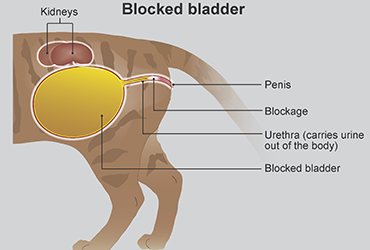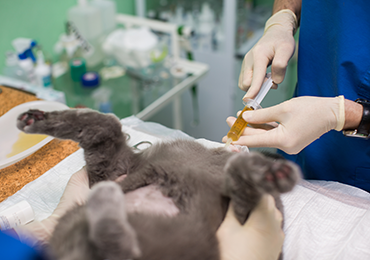Blocked Bladder in cats
Overview
- Having a blocked bladder (being unable to pee) is an emergency and can cause death if left untreated.
- Contact your vet for an emergency appointment if your cat is struggling to pee.
- A blocked bladder is often caused by an underlying problem such as stress, inflammation, infection or bladder stones.
- Your cat will need admitting into the veterinary hospital for treatment.
- Lifelong care will be necessary to reduce the chance of another blockage.
- Blocked bladders are most common in male, neutered, overweight, stressed cats, and cats that eat a dry diet.
What is a blocked bladder?
A blocked bladder means that your cat can’t pee This leads to urine building up inside the bladder until it reaches bursting point. A blocked bladder is extremely serious and left untreated it can cause kidney damage, heart problems and may even burst – causing peritonitis and death.
A blocked bladder can be caused by:
- Feline idiopathic cystitis (FIC) – very common
- Crystals in the urine
- Bladder stones
- Bladder infections (cystitis)
- Bladder tumours
- A narrow urethra.
Female cats very rarely develop blocked bladders. Male cats are much more likely to develop the condition because their urethra (the tube that drains urine from the bladder) is much longer, narrower and prone to blockage. Blockages are most common in overweight cats, indoor cats, neutered cats, stressed cats and cats that eat dry food.

A blocked bladder stops your cat from peeing
Symptoms
You may notice your cat struggling to pee, or showing signs of a urine infection before they develop a blocked bladder – urgent treatment is required if you notice these symptoms.
A blocked bladder may cause the following symptoms:
- Frequent visits to the litter tray producing little or no urine
- Straining to pee (as if they are constipated)
- Crying-out when trying to pee
- Excessive licking around their back end
- Blood in their urine
- Eating less or off food completely
- A painful, tense tummy
- Vomiting
- Hiding away
- Low energy or weakness.
Treatment
If your cat has a blocked bladder, they will need intensive care in a veterinary hospital until they’re out of danger and their bladder is working again – this will take a few days.
Your cat will need their bladder unblocked (under anaesthetic), a fluid drip and some investigations to find out what has caused the problem.
It’s possible to unblock most bladders by putting a thin tube into the penis and allowing the urine to drain out. Your vet will then use a variety of drugs and fluids to treat any infection, crystals, spasm or pain.
Some cats require surgery – for instance if a large stone is blocking the tube and needs removing, or if the urethra (tube that drains urine from the bladder) is too narrow. Sadly, there are some blockages that aren’t easy to treat, such as large tumours.

This cat is under anaesthetic having his bladder unblocked and drained
Care after a blockage
After your cat has blocked once, there is a chance they will block again. To prevent this happening, you will need to follow your vet’s advice and make some changes to your cat’s lifestyle and diet. These changes may include:
- Feeding a special food (for life)
- Encouraging them to drink more
- Reducing daily stress levels
- Weight loss (if overweight)
- Medication to treat infection, pain, spasm or crystals.
It’s very important to keep an eye on your cat’s toileting habits if they have suffered a blocked bladder in the past.
Your vet may ask you to collect a urine sample from your cat and bring it to check up appointments. Watch our video below on collecting a urine sample from your cat.
Cost
Treatment for a cat with a blocked bladder can become very expensive, especially if they are prone to the condition. Consider insuring your cat as soon as you get them, before any signs of illness start. This will ensure you have all the support you need to care for them.
It’s also very important to speak openly to your vet about your finances, the cost of treatment, as well as what you think is right for your cat. There are often several treatment options so if one doesn’t work for you and your cat, then your vet may be able to offer another.
Published: June 2019
Did you find this page useful?
Tell us more
Please note, our vets and nurses are unable to respond to questions via this form. If you are concerned about your pet’s health, please contact your vet directly.
Thank you for your feedback
Want to hear more about PDSA and get pet care tips from our vet experts?
Sign up to our e-newsletter
Written by vets and vet nurses. This advice is for UK pets only. Illustrations by Samantha Elmhurst.

 Video found at youtu.be/rZmoiLXfDNY
Video found at youtu.be/rZmoiLXfDNY
